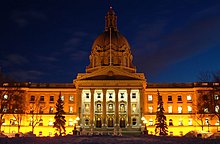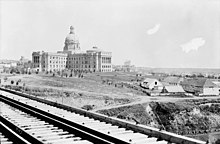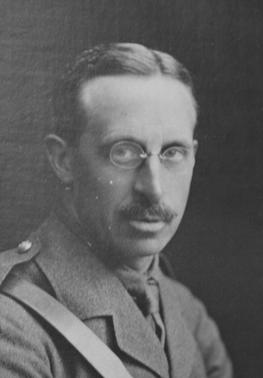
Percy Erskine Nobbs was a Canadian architect who was born in Haddington, East Lothian, and trained in the United Kingdom. Educated at the Edinburgh Collegiate School and Edinburgh University, he spent most of his career in the Montreal area. Often working in partnership with George Taylor Hyde, Nobbs designed a great many of what would become Montreal's heritage buildings and was a key Canadian proponent of the Arts and Crafts Movement in architecture. He served as the director of McGill University's School of Architecture for ten years and designed many buildings on the campus as well as McGill's Coat of Arms, which continues to be used today.

The Legislative Assembly of Alberta is the deliberative assembly of the province of Alberta, Canada. It sits in the Alberta Legislature Building in Edmonton. Since 2012 the Legislative Assembly has had 87 members, elected first past the post from single-member electoral districts. Bills passed by the Legislative Assembly are given royal assent by the lieutenant governor of Alberta, as the viceregal representative of the King of Canada. The Legislative Assembly and the Lieutenant Governor together make up the unicameral Alberta Legislature.
Lois Elsa Hole, CM, AOE DStJ was a Canadian politician, businesswoman, academician, professional gardener and best-selling author. She was the 15th Lieutenant Governor of Alberta from 10 February 2000 until her death on 6 January 2005. She was known as the "Queen of Hugs" for breaking with protocol and hugging almost everyone she met, including journalists, diplomats and other politicians.

The Ontario Legislative Building is a structure in central Toronto, Ontario, Canada. It houses the Legislative Assembly of Ontario, and the viceregal suite of the Lieutenant Governor of Ontario and offices for members of the provincial parliament (MPPs). The building is surrounded by Queen's Park, sitting on that part south of Wellesley Street, which is the former site of King's College, which was leased from the university by the municipal government of Toronto in 1859, for a "peppercorn" payment of CAD$1 per annum on a 999-year term. The southern portion of the site was later handed over to the provincial government.

Government House is the former official residence of the lieutenant governors of Alberta. Located in Edmonton's Glenora neighbourhood, since 1964 the restored and repurposed building has been used by the Alberta provincial government for ceremonial events, conferences, and some official meetings of the caucus.

The Saskatchewan Legislative Building is located in Regina, Saskatchewan, Canada, and houses the Legislative Assembly of Saskatchewan.

Downtown Edmonton is the central business district of Edmonton, Alberta. Located at the geographical centre of the city, the downtown area is bounded by 109 Street to the west, 105 Avenue to the north, 97 Street to the east, 97 Avenue and Rossdale Road to the south, and the North Saskatchewan River to the southeast.

By the arrangements of the Canadian federation, Canada's monarchy operates in Alberta as the core of the province's Westminster-style parliamentary democracy. As such, the Crown within Alberta's jurisdiction is referred to as the Crown in Right of Alberta, His Majesty in Right of Alberta, or The King in Right of Alberta. The Constitution Act, 1867, however, leaves many royal duties in Alberta specifically assigned to the sovereign's viceroy, the Lieutenant Governor of Alberta, whose direct participation in governance is limited by the conventional stipulations of constitutional monarchy.

The monarchy of Canada forms the core of each Canadian provincial jurisdiction's Westminster-style parliamentary democracy, being the foundation of the executive, legislative, and judicial branches of government in each province. The monarchy has been headed since September 8, 2022 by King Charles III who as sovereign is shared equally with both the Commonwealth realms and the Canadian federal entity. He, his consort, and other members of the Canadian royal family undertake various public and private functions across the country. He is the only member of the royal family with any constitutional role.

Rossdale is a river valley neighbourhood in the city of Edmonton, Alberta, Canada, located immediately south of the downtown core. It is a popular residential neighbourhood with easy access to downtown, the University of Alberta, the Edmonton river valley park system, and other amenities.
Louis Davies Hyndman, was a Canadian lawyer and politician from Alberta. He served as a Member of the Legislative Assembly of Alberta for 19 years and was a member of Premier Peter Lougheed and Don Getty's Cabinets. Hyndman was named the 15th Chancellor of the University of Alberta on June 10, 1994. From 1993 through 1996, he was Honorary Captain of the 4th Destroyer Squadron, Royal Canadian Navy.

Edmonton-Whitemud is a provincial electoral district for the Legislative Assembly of Alberta, Canada. In 1989, its constituents unseated the Premier of the day, Donald Getty, by voting for Liberal candidate Percy Wickman.
Richard Karl Alfred Starke is a Canadian politician who represented the electoral district of Vermilion-Lloydminster in the Legislative Assembly of Alberta. Starke was elected to his first term as MLA for Vermilion-Lloydminster on April 23, 2012. Starke was appointed the minister for Tourism, Parks, and Recreation on February 4, 2013. He was not included in the Cabinet sworn in on September 15, 2014, but was appointed Chair of the Rural Health Services Review Committee on September 23, 2014. He is one of only two PC MLAs to be elected outside the city of Calgary in the 2015 provincial election.

The Queen Elizabeth II Building, previously known as the Federal Public Building, is an eleven-storey Art Deco building in downtown Edmonton, Alberta. Built with granite and Tyndall stone, the building is located in the northeast corner of the Alberta Legislature grounds, overlooking the Capital Plaza. It hosts provincial government employees and Members of the Legislative Assembly (MLA), and is considered one of Edmonton's most significant modern buildings.

McKay Avenue School is a former school and historic site in Edmonton, Alberta, Canada. The site is a Provincial and Municipal Historic Resource, and home to the Edmonton Public School Board's archives and museum.

Edmonton-City Centre is a provincial electoral district in Alberta, Canada. The district is one of 87 districts mandated to return a single member (MLA) to the Legislative Assembly of Alberta using the first past the post method of voting. The current MLA is David Shepherd, first elected in the 2019 Alberta election.
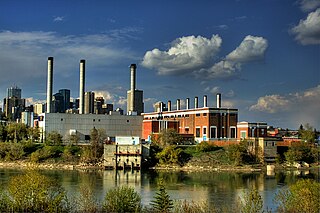
The Rossdale Power Plant is a decommissioned natural gas power plant located in Edmonton, Alberta, Canada. The power plant is located along the North Saskatchewan River in the Rossdale community, neighbouring the EPCOR water treatment plant to the east and a native burial ground to the west. The plant's remaining three remaining structures, the Low Pressure Plant, Pumphouse No. 1 and the Administration building are designated as Alberta Provincial Historic Resources.
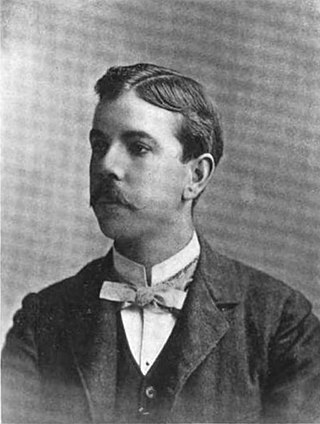
Allan Merrick Jeffers (1875–1926) was an American architect who practiced largely in Alberta, Canada.

Wetaskiwin Court House is a courthouse and National Historic Site of Canada located in the city of Wetaskiwin, Alberta.


